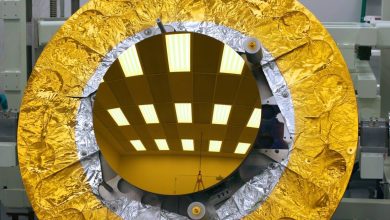Presence of water-ice likely outside Moon’s polar regions as well: Chandrayaan-3 data | Technology News

WATER-ICE ON the Moon could be more prevalent than understood earlier. A new analysis of data from one of the instruments aboard Chandrayaan-3 suggests that there was a good probability that water-ice was present in locations outside of the polar regions of the Moon.
Using data from Chandra’s Surface Thermophysical Experiment (ChaSTE), scientists at the Ahmedabad-based Physical Research Laboratory have shown that surface and sub-surface temperatures in the higher latitudes of the Moon’s surface varied greatly with even very small changes in altitudes over a short distance. Inclined areas in these latitudes that were not directly facing the Sun could have environments very similar to the polar regions, and could host water-ice below the surface.
The findings have been published in the Communications Earth and Environment journal, a Nature publication.
ChaSTE, which is a sort of a thermometer, was the first instrument to carry out on-site temperature measurements of the Moon’s surface and sub-surface near the polar regions. Previous estimates of temperatures in these regions came from satellite measurements.
ChaSTE had earlier revealed that there was a difference of nearly 60 degree Celsius between the temperature of the Moon’s surface, and the layer just 10 cm beneath it. This extreme non-conductivity of heat by the top layer of lunar surface shed new light about the composition and evolution of the Moon, and could have interesting practical implications like creating temperature-controlled habitats for future human visitors.
A research team led by K Durga Prasad at PRL used the temperature data recorded by ChaSTE to infer the possibility of water-ice in locations similar to Shiv Shakti point where Chandrayaan-3 had landed.
As of now, water-ice on the Moon is understood to be present only in the polar regions, particularly under the craters where the Sun’s rays are unable to reach. Chandrayaan-3 had landed around 70 degree South, closest to the lunar South Pole that any spacecraft has landed but not quite in the polar region.
Story continues below this ad
Prasad’s team noticed large variations in surface temperatures over very short distances depending on whether a location was flat or on an incline, and whether it was facing the Sun or away from it.
Finding water on Moon
TWO INSTRUMENTS onboard Chandrayaan-1 had confirmed the presence of water on Moon. Their observations had found strong signals of water in the polar regions, including thick deposits of water-ice. Now, Chandrayaan-3 is suggesting that the prevalence of water-ice might not be confined to the polar regions only, and could be found in the areas immediately outside as well.
The Vikram lander of Chandrayaan-3 had landed on a slightly inclined location.
The place where ChaSTE penetrated the surface, on a slope facing the Sun, the temperature was recorded to be 355 Kelvin (about 82 degree Celsius). Just about a metre away, where the surface was relatively flatter, another sensor onboard the Vikram lander, measured the temperature to be about 332 K (about 59 degree Celsius).
“ChaSTE observations suggest that the lunar surface temperatures show a significant spatial variability at metre scales. The sunward (sun-facing) slopes are found to be recording much higher temperatures (~30 K or more) in comparison to flat locations or poleward (anti-Sunward) slope regions,” the study said.
Story continues below this ad
On its own, low surface temperatures are not evidence of the presence of water-ice, but do offer interesting clues for further examination. Huge temperature difference over such small distances can reveal new insights about the properties of the lunar surface and what lies beneath.
The study said such small inclines in the high-latitude regions (60-80 degrees north or south of equator), particularly when they were not facing the Sun, could be hosting environments that were similar to the ones existing in the polar regions.
“The interesting outcome is that the high latitude sites with local slope (incline) greater than 14 degree in poleward direction might offer a similar environment as polar sites for accumulating water ice at shallow depths,” it said.
“ChaSTE findings not only indicate fine scale spatial variability in regolith (upper layer of the surface) temperatures but also suggest that high-latitude regions are potential sites for scouting water-ice, resource prospecting and habitation. Such sites are not only scientifically interesting but also pose less technical challenges for exploration in comparison with regions closer to the poles of the Moon,” it said.




